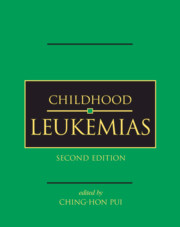Book contents
- Frontmatter
- Contents
- List of contributors
- Preface
- Part I History and general issues
- Part II Cell biology and pathobiology
- Part III Evaluation and treatment
- 14 Pharmacokinetic, pharmacodynamic, and pharmacogenetic considerations
- 15 Assays and molecular determinants of cellular drug resistance
- 16 Acute lymphoblastic leukemia
- 17 Relapsed acute lymphoblastic leukemia
- 18 B-cell acute lymphoblastic leukemia and Burkitt lymphoma
- 19 Acute myeloid leukemia
- 20 Relapsed acute myeloid leukemia
- 21 Myelodysplastic syndrome
- 22 Chronic myeloproliferative disorders
- 23 Hematopoietic stem cell transplantation
- 24 Acute leukemia in countries with limited resources
- 25 Antibody-targeted therapy
- 26 Adoptive cellular immunotherapy
- 27 Gene transfer: methods and applications
- 28 Minimal residual disease
- Part IV Complications and supportive care
- Index
- Plate Section between pages 400 and 401
- References
19 - Acute myeloid leukemia
from Part III - Evaluation and treatment
Published online by Cambridge University Press: 01 July 2010
- Frontmatter
- Contents
- List of contributors
- Preface
- Part I History and general issues
- Part II Cell biology and pathobiology
- Part III Evaluation and treatment
- 14 Pharmacokinetic, pharmacodynamic, and pharmacogenetic considerations
- 15 Assays and molecular determinants of cellular drug resistance
- 16 Acute lymphoblastic leukemia
- 17 Relapsed acute lymphoblastic leukemia
- 18 B-cell acute lymphoblastic leukemia and Burkitt lymphoma
- 19 Acute myeloid leukemia
- 20 Relapsed acute myeloid leukemia
- 21 Myelodysplastic syndrome
- 22 Chronic myeloproliferative disorders
- 23 Hematopoietic stem cell transplantation
- 24 Acute leukemia in countries with limited resources
- 25 Antibody-targeted therapy
- 26 Adoptive cellular immunotherapy
- 27 Gene transfer: methods and applications
- 28 Minimal residual disease
- Part IV Complications and supportive care
- Index
- Plate Section between pages 400 and 401
- References
Summary
Introduction
Acute myeloid leukemia (AML) is a heterogeneous group of hematopoietic malignancies characterized by the proliferation of abnormal leukemic blast cells and impaired production of normal blood cells. AML accounts for only 15% to 20% of cases of acute leukemia in children and adolescents, but is responsible for more than one third of the deaths due to leukemia in these age groups.
The outcome of treatment for children with AML has improved markedly over the last three decades: about half of all affected children now remain free of disease at 5 years from diagnosis and are probably cured. This improvement has been accomplished by enrolling pediatric patients in clinical trials, administering more intensive therapy (including hematopoietic stem cell transplantation), and improving supportive care. However, the cure rate for children with AML continues to lag behind that for children with acute lymphoblastic leukemia (ALL). The main reasons for treatment failure are relapse and treatment-related mortality. A major challenge is the development of novel therapies that overcome drug resistance and decrease relapse rates, while reducing the short- and long-term adverse effects of treatment. Recent advances in understanding the molecular heterogeneity of AML and in identifying specific molecular therapeutic targets should provide essential information needed to meet this challenge. Here we update findings on the epidemiology and pathogenesis of AML in children and adolescents and discuss treatment options, supportive care issues, and complications of therapy.
Epidemiology and risk factors
AML accounts for approximately 16% of the acute leukemias in children and adolescents younger than 15 years.
- Type
- Chapter
- Information
- Childhood Leukemias , pp. 499 - 539Publisher: Cambridge University PressPrint publication year: 2006
References
- 2
- Cited by



